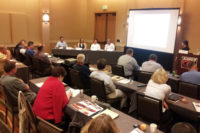“We do not hold the keys to all of the solutions to keep our country safe and secure – you do. There is always an opportunity for you to work with the U.S. government,” said William N. Bryan, Acting Under Secretary for Science and Technology for the DHS Security Science and Technology Directorate (S&T).
In a keynote presentation yesterday morning, Bryan stressed how S&T wants to work with the security industry, across the globe, to accelerate R&D and deliver solutions that enable communities to adapt and respond to the speed of innovation and complex threat cycles.
“We can’t do it alone,” Bryan said. “We want your ideas, and we will cherish them. Homeland security is a team sport, collaboration is critical and the diversity of perspectives is essential to our success.”
Bryan began his presentation by discussing the challenges of security and safety in a digital age, where security threats are persistent and often unstoppable. “With technology brings risk,” he said. “On an average day, look at how many web enabled applications you use – email, social media, banking, your home security system and more. We have a lot of confidence in that those applications are safe and secure. The pervasiveness of those applications and the willingness of young people to embrace it changes the R&D landscape. As soon as we come up with a product to address a threat, the bad actors adapt.”
There are pros and cons to technology, Bryan said, but we have to be mindful of how technology is used, citing drones that offer multiple benefits with security and life safety, but there are some who do not operate them safely and responsibly. In addition, home security cameras allow homeowners to know when a package is delivered at their door, yet bad actors can tap into those systems and manipulate the video, he said. Even more, the Internet of Things is enabling all things to operate but it can also disrupt, and destroy all good things that technologies were designed to do, he noted.
“In a perfect world, as these technologies are developed, security mitigations should also be developed. We are seeing the consequences of when security becomes an afterthought in the development of technology, as it is difficult to retrofit security into a technology. As an industry, we have to do a better job of that. It is a shared challenge and responsibility,” Bryan said.
Bryan ended the presentation by asking attendees to work with DHS and S&T. He said, “Our success at S&T is measured by us developing solutions. We do not have the resources and we cannot do it alone. Because we are a law enforcement agency, the threats that we see today need solutions tomorrow. Collaborating with industry and government is not unusual. We currently work with carriers to look at 5G interoperability, and DHS is the largest user of biometrics.”
“My charge to you is to work with us to innovate and help us to implement solutions that will keep our country safe,” he said.






